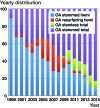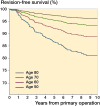Lower age increases the risk of revision for stemmed and resurfacing shoulder hemi arthroplasty
- PMID: 29202632
- PMCID: PMC5810830
- DOI: 10.1080/17453674.2017.1411081
Lower age increases the risk of revision for stemmed and resurfacing shoulder hemi arthroplasty
Abstract
Background and purpose - The number of patients where shoulder hemiarthroplasty (SHA) is an option is still substantial. Descriptive analyses performed by the Swedish Shoulder Arthroplasty Registry (SSAR) showed that while patients receiving SHA designs, i.e. resurfacing hemi (RH) and stemmed hemi (SH), reported similar shoulder functionality and quality of life, the revision rate for RH (12%) was larger than for SH (6.7%); this difference was studied. Patients and methods - All primary SHA (n = 1,140) for OA reported to SSAR between 1999 and 2009 were analyzed regarding risk factors for revision and PROM outcome, 950 shoulders with primary OA (POA), and 190 secondary OA (SOA). Mean age was 67.4 years (SD 10.8). PROM including WOOS and EQ-5D were collected at 5 years, until December 31, 2014. Results - 76/950 prostheses because of POA and 16/190 prosthesis because of SOA were revised. Age at primary surgery was the main factor that influenced the risk of revision, lower age increased the risk of revision, and was also the explanation for the difference between SH and RH. We also found that SH and RH had similar outcomes measured by PROM, but the POA group had higher scores than the SOA group with a clinically relevant difference of 10% in WOOS. Interpretation - The risk of revision for SH and RH is similar when adjusted for age and does not depend on primary diagnosis or sex. A lower age increases the risk of revision. Patients suffering from POA experience better shoulder functionality than SOA patients irrespective of implant type.
Figures




References
-
- Burgess D L, McGrath M S, Bonutti P M, Marker D R, Delanois R E, Mont M A.. Shoulder resurfacing. J Bone Joint Surg Am 2009; 91 (5): 1228–38. - PubMed
-
- Dillon M T, Inacio M C S, Burke M F, Navarro R A, Yian E H.. Shoulder arthroplasty in patients 59 years of age and younger. J Shoulder Elbow Surg 2013; 22 (10): 1338–44. - PubMed
-
- EuroQol Group. EuroQol: A new facility for the measurement of health-related quality of life. Health Policy Amst Neth 1990; 16 (3): 199–208. - PubMed
MeSH terms
LinkOut - more resources
Full Text Sources
Other Literature Sources
